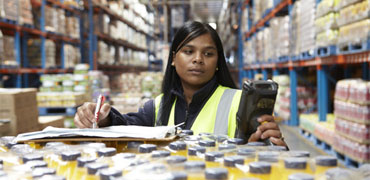During a global crisis, values like security, safety and sustainability are perhaps more front of mind for everyone, including manufacturers.
Yet many organisations are hesitating to adopt the technology that can help them achieve against these objectives because they worry about additional risk, cost, and disruption. But as we move into a new phase of recovery, should these concerns prevent consumer goods companies from joining the fourth revolution?
In this blog post, I look at why embracing innovation doesn’t mean compromising on security, safety and sustainability concerns.
Security is critical to Industry 4.0
In the past year, several industry giants were the focus of large-scale cyberattacks. In fact, a recent study found that half of UK manufacturers had fallen victim to some form of cybercrime1 and, during 2020, incidents have only increased. If factories want to go digital, they’ll need to connect their IT to their OT. But this could open up the production line to the risk of attack. As well as any financial theft, a known data breach can also result in large regulatory fines. Even worse, if it becomes public knowledge, customer trust in an organisation can take a hit.
The threat landscape has certainly evolved during the pandemic. The sudden shift to homeworking and widespread adoption of the cloud has increased the amount of vulnerable end points across many networks. Moving to industrial IoT platforms means even more connected devices and data to protect. Organisations need to find defensive strategies to monitor suspicious behaviour, encrypt important data, identify insecure end points and if necessary, segment networks to combat malicious interference. There’s a lot to consider. All this makes an integrated, robust, security solution essential because only building in a cybersecurity wrap can bring IT and OT together and keep the plant safe at the same time.
Innovation can increase workplace safety
Now more than ever, we’re anxious about our wellbeing and, new regulations like social distancing are adding to legislation in the workplace. But smart technologies offer innovative ways to help with safety compliance.
Computer vision technology shows huge potential for limiting accidents through real-time object detection. This technology watches over your factory floor for you, making sure staff follow health and safety guidance and wear the right PPE. Intelligent automation and augmented maintenance are also delivering valuable safety benefits. Augmented reality applications limit the number of technicians that have to go into dangerous environments to fix issues. And predictive maintenance tools, powered by IoT systems, spot problems and prevent failures, improving safety. Plus, the warnings lengthen asset life, reduce unplanned downtime, and prevent costly outages.
Technology can drive sustainability forward
Consumers increasingly expect companies to be environmentally conscious and energy efficient. Studies show that 82% of consumers are now looking to make more sustainable purchases2 and reducing your carbon footprint is essential if customers are going to keep on buying. Industry 4.0 offers ways of boosting production while being environmentally friendly. An AI-driven energy efficiency solution can monitor how you manage resources and provide helpful recommendations in real time. These suggestions optimise your energy consumption and help to reduce your overall carbon footprint.
Using the latest technology, doesn’t mean you have to be less sustainable. Smart manufacturing also generates a huge amount of data, and if this is fed to machine learning models, the resulting insights can drive productivity and refine sustainable processes. Virtual reality applications mean that designers who used to spend weeks developing physical prototypes, can create digital ones in a matter of days. Not only does this hugely accelerate product development and save time and money, but it also limits unnecessary use of resources.
Make connection your first concern
It’s important to remember that the factory of the future is only as powerful as the connection it relies on. We offer a choice of connectivity solutions to support your digital transformation, including SD-WAN to optimise network traffic, 5G connectivity and cloud solutions, and our experts will help you find the right technology and security for your specific needs.
With these foundations in place, you’ll be able to use our range of intelligent manufacturing solutions which include computer vision technology, augmented reality applications and machine learning tools.
Find out how you can access these innovations and transform your supply chain by downloading our latest brochure or by visiting Digital Consumer Goods.
1The Grocer, ‘What’s happening to grocery shopping habits as lockdown eases?’, 2020
2Accenture, 2020 – change to: Accenture, ‘How will COVID-19 change the consumer?’ 2020

